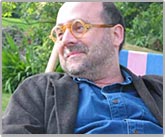|

Kenneth Caldwell
Photo: Paul Crabtree
|
|
 |
California Dreaming
By Kenneth Caldwell
Eichler: Modernism Rebuilds the American Dream
Written by Paul Adamson
Compiled by Marty Arbunich
Photography by Ernie Braun
Gibbs Smith, 2002
240 pages, $50
The connection between parking, the subject of this issue, and Eichler Homes is that the automobile makes these houses possible, for better or worse. There are plenty of critics of parking, but as Bryan Shiles points out in his interview elsewhere in this issue, our mode of transport is here to stay. Some have criticized Eichler homes because they did not improve a great deal on the isolated and wasteful pattern of suburban development and because they tended to turn their back to the street like Wright's Usonian houses. Having walked around Eichler neighborhoods in Northern and Southern California I confess a fondness for the lushly landscaped quiet and the series of rooflines that look faintly Japanese. They are better than most suburbs, still the preferred neighborhood choice of most Americans.
Eichler: Modernism Rebuilds the American Dream is the second book on the topic and a vast improvement over Eichler Homes: Design for Living, the modest volume published by Chronicle Books in 1996. This new work is handsome and rides the continuing wave of nostalgia for mid-century design. However, it seems caught between the scholar's desk and the coffee table; on the one hand it is a significant investigation into a cultural phenomenon, and on the other a catalogue raisonne of Eichler Homes's promotional materials.
Joseph Eichler, a California businessman turned developer, believed that he could sell architect-designed tract homes that captured the modernist spirit to the middle class in the 1950s and 1960s. He saw modern architecture's potential for improving people's lives and made some core ideas of the modern movement available to popular culture.
It is doubtful that these few thousand homes, mainly in California, could indeed have rebuilt the American dream, and despite the clarity of the graphics and plans, the book is a victim of its own marketing. Neither the beautiful mid-century photography nor the text explain the nature of this dream and why it needed to be rebuilt. Many of the houses' design elements, such as the wood post-and-beam construction and the relationship to the outdoors, seem specifically tailored to the mid-century California dream instead.
In her foreword, noted scholar Gwendolyn Wright makes the point that most Americans prefer suburban housing, and she provides the context for trying to understand suburbia and the Eichlers' place in that development pattern. Paul Adamson, a practicing architect, writes comprehensively about Eichler himself, his architects, the technology, the marketing, and the kinds of communities that got built.
In the preface the author is at his strongest, explaining his personal connection to the social history of the era and to the Eichlers themselves. Despite some uneven writing-events are repeated several times and some of the chapters are too long-the text explains why the Eichlers remain relevant today; the construction techniques provided innovations in building technology and economies of scale, and prefigured the resurgence of interest in prefabrication and preassembled homes. Adamson also grapples with issues of suburbia and new urbanism. He points out how Eichler incorporated shared spaces and community facilities, looked forward instead of backward in his designs, and often met resistance from local planning officials and lenders. Perhaps most commendably, Eichler offered his homes without racial restrictions, and remains a model for the developer willing to take aesthetic and cultural risks.
Ernie Braun's beautiful black and white promotional photos from the 1950s and 1960s support the chapter on Eichler's successful marketing, but the book could have benefited from a more critical photographic perspective. Less blatantly promotional and more contemporary photos would have helped to show how people use these spaces now and would have been in keeping with Adamson's larger view.
Despite the lack of critical photography, the book is important for serious students of California modernism and domestic architecture, and, of course, for mid-century groupies.
Kenneth Caldwell is a communications consultant and writer based in Oakland, California.
|